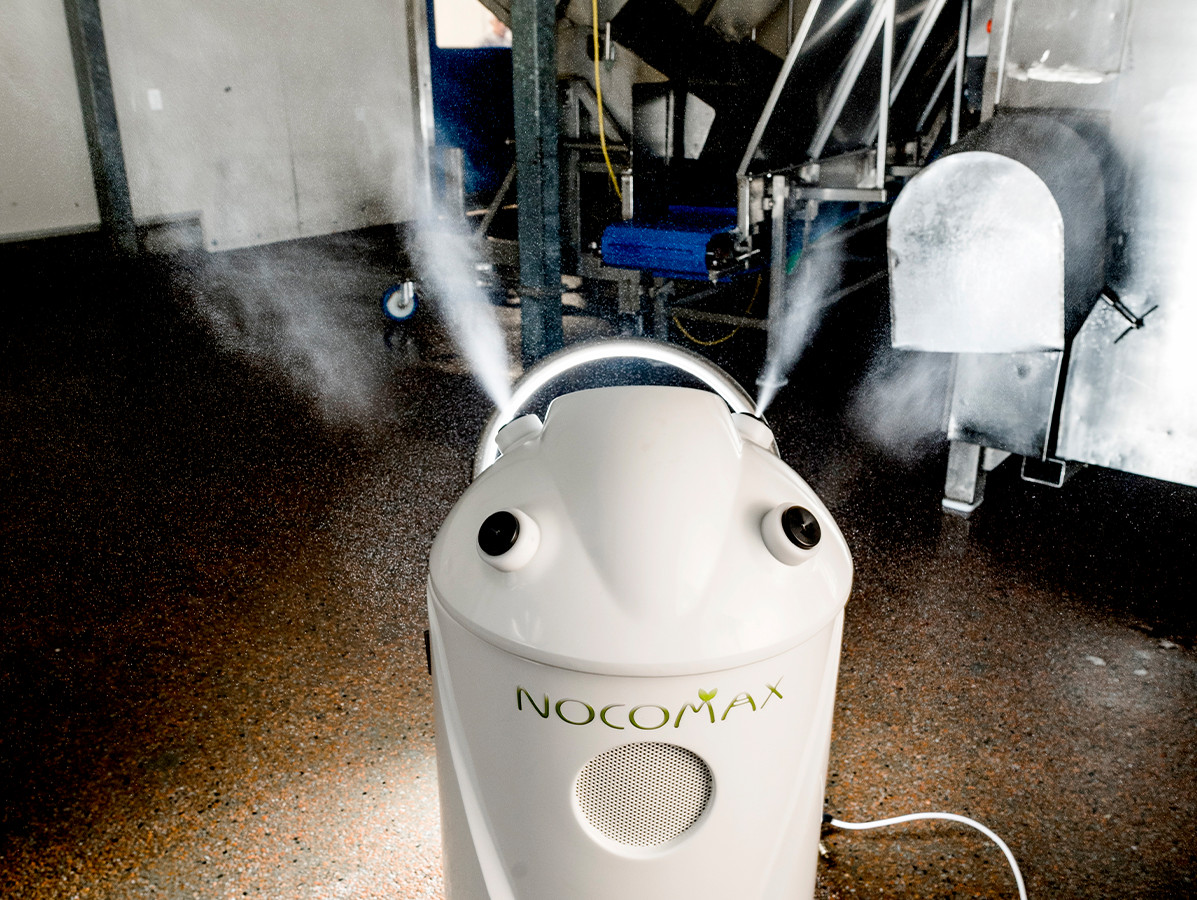
Laboratory tests have shown that the Nocotech disinfection method is effective against all microorganisms such as fungi and yeasts, Listeria and Salmonella in a room with a minimum dose.
Nocotech is an automated disinfection system consisting of a machine; the Nocospray, the Nocomax or the Nocomax Wall model, and the liquid Nocolyse Food; a chemical compound based on hydrogen peroxide (7.9%). Together they create an ionized dry disinfectant vapour. The advantage of the dry vapour is that it reaches all areas in the room, including all surfaces that are in contact with oxygen.
To create dry vapour, each Nocotech machine uses an ultra-speed turbine which blows the ionized air out of the machine at an enormous speed. This air is heated along the way, which greatly improves the process of ionization. When the ionized air is blown out of the machine, a few drops of Nocolyse Food liquid are added to the ionized air.
Through this process, the molecules of the liquid are fragmented into a ‘gaseous’ form, a dry vapour, and ionized by transfer of the positive and negative charges of the air. This creates OH-ions, which have the disinfecting effect. Therefore, it is not the droplets themselves that disinfect. It is the charged ions.
H₂O₂ in liquid form is an excellent disinfectant, but it drastically oxidises all metals. It is therefore highly corrosive. As dry vapour, H₂O₂ is no less than 16 times stronger than in liquid form. It also loses its oxidising property due to the formation of OH-ions and thus its corrosive effect. Metal, switch cabinets and any other surface does not suffer any disadvantages.
The dosage of the number of millilitres is related to the result to be achieved. In hospitals, curative treatment is used. This means that there are micro-organisms present that must be eliminated with a single treatment. Hospitals often have to deal with BRMO (Particularly Resistant Microorganisms) that are insensitive to antibiotics and can therefore be very dangerous in a hospital environment. They are also difficult to eliminate by conventional disinfection methods. With Nocotech this is possible. The dosage for such a single treatment is often 4, 5 or 6 ml/m³. One easily achieves a log 5 or 6 reduction, depending on the type of BRMO. This is enough reduction to be able to use the room safely afterwards.
In the food industry this is different. Here we disinfect on a daily basis, you could say preventively. As long as the disinfection is stronger than the increase in microorganisms during a production day, the infection pressure drops. The daily disinfection can suffice with only 1 ml/m³. Moreover, we hardly encounter BRMO in the food industry.
The Nocotech method has been tested by several independent laboratories on a number of types of micro-organisms. It is widely known in the medical world that these microorganisms are killed with a dosage of 4, 5 or 6 ml/m³. It is interesting to know how big the reduction is with a dosage of 1 ml/m³, as used in the food industry.
In the overview below we present the results:
|
|
T0 |
T1 |
T2 |
T3 |
|
Staphylococcus |
164 |
20 |
0 |
0 |
|
E.coli |
34324 |
946 |
0 |
0 |
|
Yarrowia (yeast) |
10 |
0 |
0 |
0 |
|
Aspergillus (mould) |
25180 |
20 |
0 |
0 |
|
Listeria |
814414 |
18559 |
0 |
0 |
|
Salmonella |
42432 |
5581 |
236 |
0 |
|
Pseudomonas |
153 |
60 |
0 |
0 |
The numbers are the number of cfu (colony forming units)
T0 - are the initial values
T1 - are the values after 1 treatment with 1 ml/m³
T2 - are the values after the 2nd treatment. Only Salmonella is still present because this is a rapidly growing type of Salmonella, and is present for 24 hours between each treatment.
T3 - The last colonies of Salmonella have also been eliminated.
Testing in a laboratory is always different from practice. In a laboratory, the micro-organisms on a contaminated plate are easily accessible to the dry vapour. In practice, microorganisms are 'hidden' in nooks and crannies, we have to deal with high humidity and air currents. On the other hand, in practice one seldom finds numbers of cfu's of microorganisms as grown in a laboratory.
These tests convincingly prove that an enormous reduction can be achieved with a single treatment with minimal dosage. If this treatment is repeated on a daily basis, the growth of microorganisms is completely controlled.
Source: Vakblad Voedingsindustrie 2020